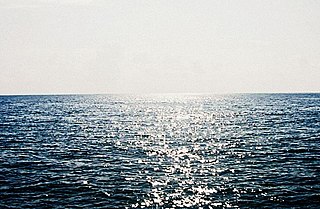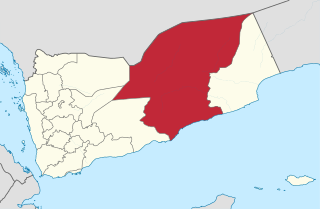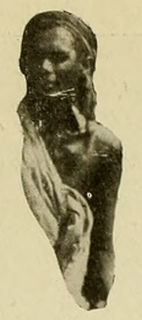
The Arabian Sea is a region of the northern Indian Ocean bounded on the north by Pakistan and Iran, on the west by the Gulf of Aden, Guardafui Channel and the Arabian Peninsula, on the southeast by the Laccadive Sea, on the southwest by the Somali Sea, and on the east by India. Its total area is 3,862,000 km2 (1,491,000 sq mi) and its maximum depth is 4,652 metres (15,262 ft). The Gulf of Aden in the west, connects the Arabian Sea to the Red Sea through the strait of Bab-el-Mandeb, and the Gulf of Oman is in the northwest, connecting it to the Persian Gulf.

Hadhramaut or Hadramawt is a governorate of Yemen. Lying within the large historical region of Hadhramaut, it is the country's largest governorate.

Hadibu, formerly known as Tamrida, is a coastal town in northern Socotra, Yemen. It is not far from the mount Jabal al-Jahir. It is the largest town of the small archipelago, with a population of 8,545 at the 2004 census. Hadibu is also the capital of the larger eastern district of Socotra's two administrative districts, Hidaybū. For the inhabitants of the town, animal husbandry is the main source of income.

Samhah or Samha is an inhabited island in the Guardafui Channel. A part of the Socotra archipelago, it is located between the island of Socotra and Somalia. Like the whole group, it belongs to Yemen, and is part of Socotra Governorate. There is a dispute between Yemen and Somalia's government over the island's sovereignty.

Darsah is an uninhabited island in the Guardafui Channel. It is part of the Socotra Archipelago of Yemen. Darsah and neighboring Samhah are collectively known as "Al Akhawain" which means "The Brothers". There is a dispute between Yemen and Somalia's government over the island's sovereignty.
Socotra Island has a uniquely diverse ecosystem consisting of xeric shrublands, dry hilly areas populated with endemic shrubs including the dominant Croton socotranus and Jatropha unicostata. The area is now at risk from human activities. The WWF describes the Socotran Archipelago's conservation status as "Critical/Endangered".
Continental crustal fragments, partially synonymous with microcontinents, are fragments of continents that have been broken off from main continental masses forming distinct islands, often several hundred kilometers from their place of origin. All continents are fragments; the terms "continental fragment" and "microcontinent" are usually restricted to those smaller than Australia, due to Australia being the smallest continent. They are not known to contain a craton or fragment of a craton. Continental fragments include some seamounts and underwater plateaus.

Dracaena cinnabari, the Socotra dragon tree or dragon blood tree, is a dragon tree native to the Socotra archipelago, part of Yemen, located in the Arabian Sea. It is so called due to the red sap that the trees produce.
Hidaybu District is one of two districts of the Socotra Governorate, Yemen. It occupies the eastern part of the main island of Socotra archipelago. It is named after its capital and the principal town of the archipelago, the town of Hidaybu (Hadibu). As of 2003, the district had a population of 34,011 people.

Qulensya Wa Abd Al Kuri District is one of two districts of the Socotra Governorate, Yemen. It occupies the western part of the main island of Socotra archipelago, and all other islands of the archipelago. It is named after its capital, Qulensya, on the north coast of Socotra island, and Abd al Kuri, the second largest island of the archipelago. As of 2003, the district had a population of 10,109 inhabitants.

Mormogystia brandstetteri is a moth in the family Cossidae. It is endemic to the Socotra Archipelago, part of Yemen in the Indian Ocean.

Meharia yakovlevi is a moth in the family Cossidae. It is found in Socotra, Yemen.

Aethalopteryx diksami is a moth in the family Cossidae. It is found in Socotra, Yemen, where it is only known from the central part of Socotra Island from two valleys: the Diksam canyon and the Difarroha valley, which are characterized by the following relict woody vegetation: Dracaena cinnabari, Buxus hildebrandtii, Croton socotranus and numerous other endemic plants.

Socotra Archipelago or Suqutra is officially one of the governorates of Yemen. It is composed of the archipelago of Socotra.
Pellenes striolatus is a jumping spider species in the genus Pellenes. It lives on the Socotra Archipelago off the coast of the Yemen.

The Soqotri people sometimes referred to as Socotran are an ethnic group native to the island of Socotra. They speak the Soqotri language, a Semitic language in the Afroasiatic family.

On 30 April 2018, the United Arab Emirates (UAE) deployed more than a hundred troops with artillery and armored vehicles to the Yemeni archipelago of Socotra in the Guardafui Channel without prior coordination with Yemen. The initial deployment consisted of UAE military aircraft carrying more than fifty UAE soldiers and two armored vehicles, followed by two more aircraft carrying more soldiers, tanks and other armored vehicles. Al Jazeera reported that shortly after landing, UAE forces dismissed Yemeni soldiers stationed at administrative installations such as Socotra Airport and seaports until further notice, and the flag of the United Arab Emirates was raised above official government buildings in Hadibu.

The Guardafui Channel is an oceanic strait off the tip of the Horn of Africa that lies between Somalia and Socotra. It connects the Gulf of Aden to the north with the Somali sea to the south. Its namesake is Cape Guardafui, the very tip of the Horn of Africa. Notable places of interest include the Alula Lagoon.
This page gives a summary of the islands of Somalia.















